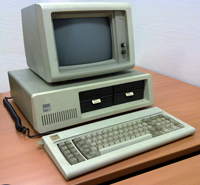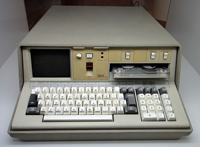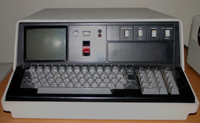Listen to the Podcast
27 Aug 2021 - Podcast #758 - (19:19)
It's Like NPR on the Web
If you find the information TechByter Worldwide provides useful or interesting, please consider a contribution.

If you find the information TechByter Worldwide provides useful or interesting, please consider a contribution.
Windows starts a lot of processes and services at boot time, and some of the applications you've installed may add more. Each of these takes a certain amount of time to start, and bottlenecks can occur when multiple applications try to start simultaneously.
Installing a solid-state disk drive as the boot device will make the computer start faster by eliminating seek time, but multiple applications can still compete with each other for simultaneous access to system resources. Admittedly, I start a lot of applications when the system boots, and that's in addition to the dozens of processes that Windows launches.
Click any small image for a full-size view. To dismiss the larger image, press ESC or tap outside the image.
I've been using Startup Delayer for several years to schedule applications in an orderly way. It's an excellent choice, but then I started using Glary Utilities, which has a similar function built it. The Glary Utilities Startup Manager seems to do a better job of identifying startup applications, but it also seems to interfere with Startup Delayer. I couldn't find a way to turn off the Glary Startup Manager, so I uninstalled the R2 Startup Delayer even though it has some features that the Glary application doesn't. As it turns out, those are features I wasn't using.
Both applications allow the user to specify which programs start with Windows and when they start. Delay times can be set to a few seconds, several minutes, or any other value. Startup Delayer allows the user to set times in hours, minutes, and seconds. The Glary application uses seconds for all settings, so you have to know that one minute is made up of 60 seconds and that an hour has 3600 seconds.
Startup Delayer allows the user to set applications to launch based on the idle percentage of the CPU and disk subsystem. Glary's utility omits this capability.
Both launch each application in the order the user specifies. Startup Delayer also allows the user to specify that an application will launch only on specific days or if an internet connection is available. These features aren't available in the Glary Startup Manager, but I've never used them.
Startup Delayer also has profiles that can be used to create and manage sets of applications that are used for specific purposes. A games profile might launch few extra applications while a work profile would launch all of the applications you need when you're working.
Some of these features are available only if you pay for the premium version of Startup Delayer that R2 Software says is currently unavailable.
The Glary Utilities Startup Manager displays information in three sections:
Right clicking an entry displays a context menu that allows the user to disable, delay, or delete an application from the startup process. When you find an application you think may be superfluous, you can disable it. If the computer subsequently starts and runs normally without that process, you may want to delete it from the list of startup applications. If disabling the process creates problems, just return to the Startup Manager and re-enable it.
If you want to undo some or all of the changes you've made recently with Startup Manager, click Undo Changes in the bottom right corner to display a dialog that lists the changes.
Many applications have settings that allow the user to start an application with Windows, but some don't. When you have a program that you want to start with Windows, but there's no option to do so, you can add the program to one of the startup folders.
The goal shouldn't necessarily be to find the shortest possible startup time. Nearly four minutes may seem excessive, but starting a lot of applications at boot time ensures that functions I'll need later will be readily available.
Searching for information about a new event can sometimes lead to what's called a "data void" in search engines. Only a few results may be returned, and some of the links may take your browser to a malicious site.
Google's Danny Sullivan described the problem on Google's blog. Reports were circulating on social media about a video of a UFO traveling at 106 miles per hour. Before going any further, let's consider that speed.
If we're looking for a craft capable of interstellar travel, 106 miles per hour would be dead slow. Even single-engine propeller-driven airplanes go faster than that. But people who used search terms such as "ufo 106 mph" or "ufo filmed traveling 106 mph" found that the search returned few hits.
Click any small image for a full-size view. To dismiss the larger image, press ESC or tap outside the image.
Google adds warnings when searches return suspiciously little information. Sullivan writes that Google has trained the systems to detect when a topic is rapidly evolving. In that case, "we'll now show a notice indicating that it may be best to check back later when more information from a wider range of sources might be available."
So this is a "data void", and they are problems for search engines, but also for applications that have search functions (YouTube for example) because they can be used to spread hate, racism, and fake news. Emotional topics based on false information can be manipulated in ways that have negative effects on society.
Microsoft principal program manager for Bing, Michael Golebiewski, and Microsoft research partner Danah Boyd have written extensively about the issue, starting in 2018.
Their report notes that "voids occur when obscure search queries have few results associated with them, making them ripe for exploitation by media manipulators with ideological, economic, or political agendas." Search engines analyze enormous amounts of data to provide the best possible information, but when a data void exists, the results can be low quality and can contain false information.
Golebiewski and Boyd identify five situations in which data voids are likely to occur:
The report says that data voids can be used to create or amplify biases and a key to reducing danger is critical thinking. It's not an easy problem to solve because of the way search engines work. They simply locate and show content that others have produced.
You can read the report on the Data & Society website (PDF document).
August 12, 1981. It seems like just a few years ago, not 40 years ago. That's when the IBM PC was released and started the process of changing just about everything. Anyone who is 40 or younger has not known a time without personal computers. Apple was selling home computers even earlier, but IBM was what got those big clunky beige boxes into offices.
Before Apple there was the Altair MITS, a kit computer that did essentially nothing. The personal computer and now smart phones (which are really just pocket-size computers that can be used to make phone calls and take pictures) have empowered people to do things that otherwise never would have been possible.
 By the time IBM released its version of a personal computer, the Apple II had been in homes and offices for several years. So had other computers such as those from Commodore, Atari, and Radio Shack. And the Xerox Palo Alto Research Center (PARC) had been experimenting for many years with "desktop" (or under-desk) computers and trying to figure out how a computer the size of a pizza box might be developed. Desktop computers are still viable, but they've largely been replaced by notebook computers, tablets, and phones.
By the time IBM released its version of a personal computer, the Apple II had been in homes and offices for several years. So had other computers such as those from Commodore, Atari, and Radio Shack. And the Xerox Palo Alto Research Center (PARC) had been experimenting for many years with "desktop" (or under-desk) computers and trying to figure out how a computer the size of a pizza box might be developed. Desktop computers are still viable, but they've largely been replaced by notebook computers, tablets, and phones.
Even IBM had several precursors to the computer that changed the world. The IBM 5150 may be the device that started the revolution, but ...
 When IBM entered the PC market in 1981, the company countered criticism that it had arrived rather late to the party by saying that IBM had been in the "personal computer" business for several years. They cited machines such as the IBM 5100 Portable Computer that the company introduced in 1975. The 5100 ran either APL ("a programming language") or BASIC ("beginners all-purpose symbolic instruction code") and came with 16K to 64K of RAM. The machines were priced between about $9000 and $20,000 — hardly in the price range of the average 1975 consumer. In addition to the price, the only applications available for the 5100 were designed for statisticians and engineers.
When IBM entered the PC market in 1981, the company countered criticism that it had arrived rather late to the party by saying that IBM had been in the "personal computer" business for several years. They cited machines such as the IBM 5100 Portable Computer that the company introduced in 1975. The 5100 ran either APL ("a programming language") or BASIC ("beginners all-purpose symbolic instruction code") and came with 16K to 64K of RAM. The machines were priced between about $9000 and $20,000 — hardly in the price range of the average 1975 consumer. In addition to the price, the only applications available for the 5100 were designed for statisticians and engineers.
 In 1978, IBM introduced the 5110 Computing System with software that could be used by businesses for accounting functions: General ledger, accounts receivable, accounts payable, and inventory control. At that time, Digital Equipment Corporation (DEC) was a leader in that market segment with its PDP series of computers.
In 1978, IBM introduced the 5110 Computing System with software that could be used by businesses for accounting functions: General ledger, accounts receivable, accounts payable, and inventory control. At that time, Digital Equipment Corporation (DEC) was a leader in that market segment with its PDP series of computers.
A year later, IBM released the 5520 Administrative System, which was arguably the first attempt to produce a general-purpose computer. The 5520 included applications for text processing and storage. Then, in 1980, the 5120 hit the marketplace priced between $9000 and $24,000. Still well outside the price range for home or individual office user, the computer had 32KB of RAM and included a "fast" (120 characters-per-second) printer. Those who bought the 5120 could also purchase applications for inventory, billing, payroll, accounts payable, accounts receivable, and general ledger accounting. In other words, these computers were still essentially competition for DEC's minicomputers.
In 1980 the IBM Office Products Division released a device they had named the "Displaywriter", the company's first desktop word processor, but some may insist that the 1964 IBM MT/ST was the company's first word processor. "MT/ST" stood for "Magnetic Tape/Selectric Typewriter". Later the MT/SC ("Magnetic Tape/Selectric Composer") combined an IBM Selectric typewriter integrated with magnetic recording and playback facilities. The MT/ST's tapes were replaced by floppy disks on the MT/SC. What they typist entered was recorded onto a cassette tape (or floppy) that could later be edited and played back. Later versions had 2 tape drives and could be used for basic mail-merge functions.
At a time when preparing anything for print required typing information and handing it off to a typesetter, the MT/ST and MT/SC machines were remarkable improvements. Some low-end typesetting jobs could be handled by the "cold-type" capabilities of these systems. The jobs still had to be pasted up manually, but the process was faster and this was effectively the beginning of the end for small typesetting operations.
When the 5150 arrived in 1981, we never looked back.